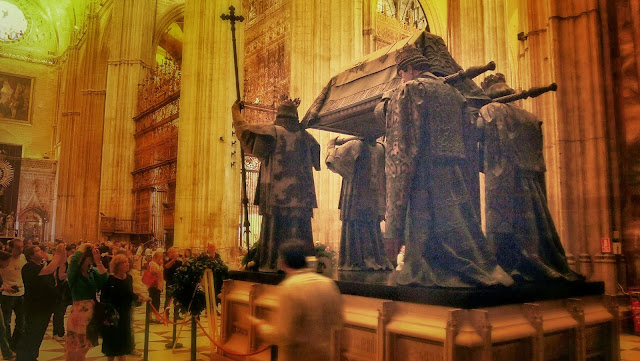Australia has had its share of 'goldrushes'... and we've seen cities designed and built on the assumption that gold would continue to flow through their streets forever. Seville has been the richest gold town the world has ever known. When Columbus stepped on his boat in the river in Seville, he changed this town forever.
Columbus was certainly motivated by the search for gold: his diary mentions gold 114 times and God 26 times. He traded for a little gold on Hispaniola, and the inhabitants traded diseases with his crew and cargo (syphilis for swine fever, apparently) but overall he and his royal sponsors were disappointed in the financial proceeds of his first voyage. It had cost 2 million maravedis, and the proceeds were worth only a few thousand.
However from 1503 - 1530, Columbus and his followers were able to loot and repatriate one tonne of gold per year. Even at this early date, the Spanish monarchy was embarking on an ambitious and expensive foreign policy, sustainable only with the expectation that it would be financed by gold from the New World. King Ferdinand quickly became desperate for more: "Get gold, humanely if you can; but at all hazards, get gold!" he wrote to the New World colonists on July 25, 1511. This was to be the theme of the Spanish monarchy for centuries.
The flow started to accelerate when Peru came on-stream in 1531. The gold and silver landing in Seville from Peru (only) are estimated to be:
Year GOLD (tonnes) SILVER (t)
1531 0.5(gold) 0.2(silver)
1532 0.5 (gold) 0.1 ( silver)
1533 5.6 (gold) 11.5 ( silver)
1534 3.5 (gold) 56.5 ( silver)
1535 1.6(gold) 27.2 (silver)
Overall, the volume must have been three times the volume coming from Peru. At a price of US$1500 per troy ounce on 12 April 2013, one tonne of gold has a current value of approximately US$48.2 million. Seville, in 1530 had a population of 150,000... 50% greater than Madrid's at that time. The general rule of thumb for sharing the gold revenue was:
:-) one-third for the crown
:-) one-third for the church
:-) one- third for the conquistadores
All that wealth sloshing around a relatively small town must have caused economic havoc.
We saw clear signs of silly spending when we visited Seville Cathedral. According to local oral tradition, the members of the cathedral chapter said: "Let us build a church so beautiful and so great that those who see it built will think we were mad". Construction began in 1402 and continued until 1506. The clergy of the parish gave half their stipends to pay for architects, artists, stained glass artisans, masons, carvers, craftsman and labourers and other expenses.
Our tour had 40 points of interest... each one being a chapel or altar of some kind... each one having unique works of art lavished with marble statues and gilded gold.
How many chapels does Virgin Mary need in one building? If you ask me, Mary gets a pretty good run from the Catholic Church. Now she did suffer labour pain in giving birth to Jesus... but one of two other ladies have experienced similar pain over the years. She did not perform any miracles... none of her sermons was recorded. She claims to be without sin... but this story of immaculate conception rings a little thin. Joseph claims to be innocent of any hanky-panky... but what about all the other lads about Nazareth at the time?
Personally, I'd like to see a few less millions spent on deifying Mary, and a couple given over to lifting the profile of Joseph.
Enough ranting for today.


No comments:
Post a Comment